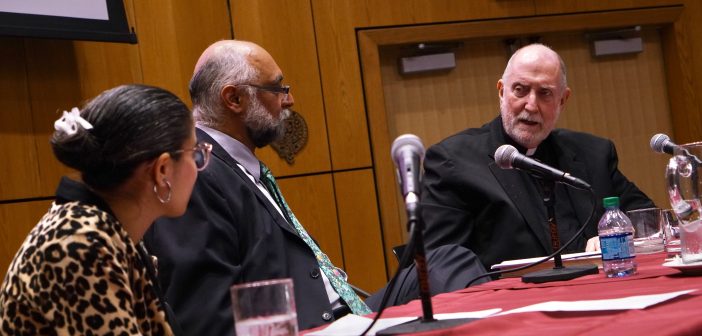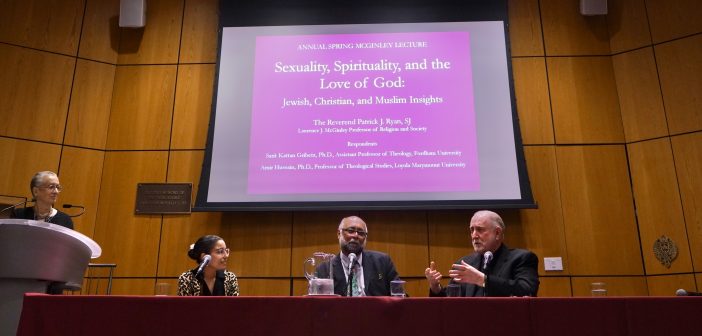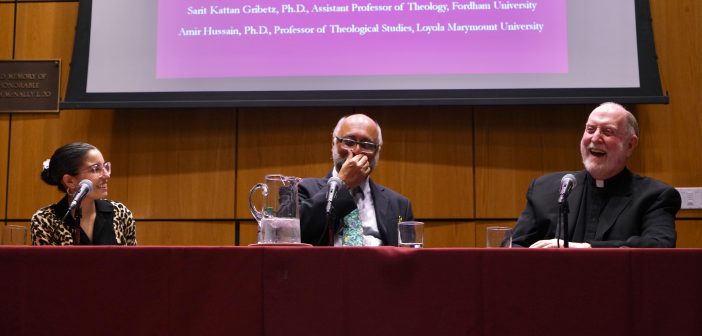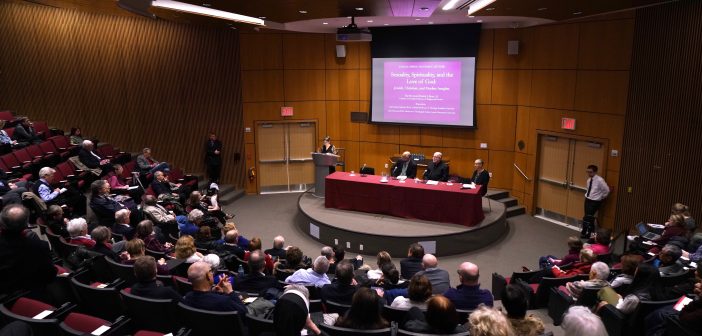This conversation is more critical than ever, said keynote speaker, Patrick J. Ryan, S.J., the Laurence J. McGinley Professor of Religion and Society. In the wake of the Catholic Church’s sexual abuse scandal, it is important to recognize that sexuality has a sacred meaning in each religion.
“I want to draw your attention to how very human forces, male and female, interact with each other in the imaginative creation of worlds of faith, worlds of spirituality,” Father Ryan said. “How, in particular, do our understandings of human sexuality color how those of us who are Jews, Christians, and Muslims think about God?”
The Bible says that God created Adam, the first human being, as both male and female. (Eve was created from one of Adam’s ribs.) This duality continues to be found in all aspects of life, including marriage, Father Ryan said. It can also be seen in male and female images in the Book of Genesis and the Song of Songs. But one of the most important texts in Judaism, the Zohar, takes a step further and suggests that humanity itself “mirrors and magnifies the Lord God,” he said.
In the same vein, Christian texts show spirituality through sexuality. For example, an autobiography by Saint Teresa of Avila, a 16th-century Christian mystic and writer, portrays the soul and God as passionate lovers, Father Ryan said. She uses graphic imagery to show the angelic piercing of her heart with the spear of God’s love: “When he drew it out, I thought he was drawing them [her entrails]out with it and he left me completely afire with a great love for God.”
The Quran also denotes spirituality through sexual language, he said. The basmalah blessing, which begins every chapter of the Quran but one, uses words that associate “the mercy of God” with a mother’s womb.
“To connect the mercy of God with a feminine physical characteristic is to understand God’s perfection as including all that is most tender in created reality, including the generative and loving characteristics of others,” Father Ryan said.
Although much of the main lecture focused on heterosexual love, respondent Amir Hussain, Ph.D., professor of theological studies at Loyola Marymount University, took a detour from the night’s discourse to reflect on the dangers faced by the LGBTQ community.
“I think of Islamic psychologists from Los Angeles, where I live, who worry about losing their license if they are anything but heteronormative,” he said. “And I wonder how we got to that place where we can hate people for the love that God has put between them.”
For Hussain, it’s a personal issue, as he was an undergraduate at the University of Toronto during the “plague years” of the ’80s, when he said he attended one too many funerals for his friends who died of HIV and AIDS.
“We have to speak out when our gay, lesbian, queer, trans, and bisexual brothers and sisters are threatened,” Hussain said. “We have to lift up the work and voices of LGBTQ scholars and activists, such as Scott Kugle at Emory University, who remind us of the inherent dignity of all of us—regardless of our sexuality.”
The scholar who delivered the Jewish response, Sarit Kattan Gribetz, Ph.D., assistant professor of theology at Fordham, compared two Biblical texts from the Old Testament: Song of Songs and Ezekiel 16. Both stories use the metaphor of a romantic partnership to show God’s relationship with Israel, she said. Only one relationship is healthy though, while the other is marred by manipulation and abuse.
Gribetz’s juxtapositions were often stark. In Song of Songs, the narrator portrays a romantic relationship between a man (God) and a woman (Jerusalem as the spouse of the Lord). Gribetz described the scenes that unfold between the lovers: “A series of kisses, love described as sweeter than wine, fragrant oils, and secluded chambers.”
Ezekiel 16, by contrast, takes a tragic turn. In it, God (a man) saves the people of Jerusalem (a woman) from slavery in Egypt, but is betrayed by the very people he rescues. The text is fraught with dark imagery: an unbathed newborn lying in the blood of her after-birth, nakedness, suffering, and violent threats.
But in these two texts, there is something to be said about humanity, Gribetz said. The stories paint a realistic portrait of the possible intersections among sexuality, spirituality, and love of God—both positive and negative.
“I chose to share with you this evening not only the positive but also the negative, not only the benevolent but also the malevolent, to highlight the empowering dimensions of religious texts, but also to acknowledge those parts of our traditions that are most problematic,” Gribetz said.
“So that we can imagine and construct together models of partnership—human and divine—that are based on mutual love and consent, rather than abuse of power and violation of dignity.”






